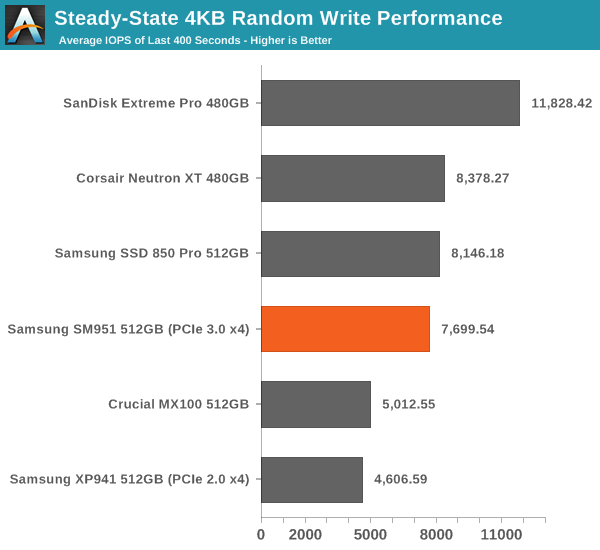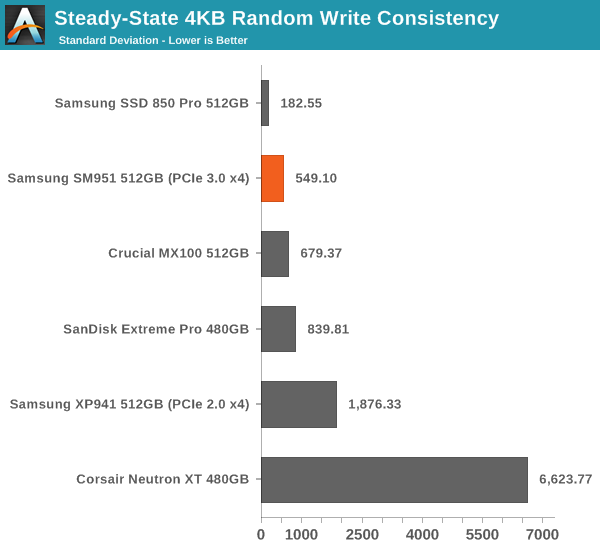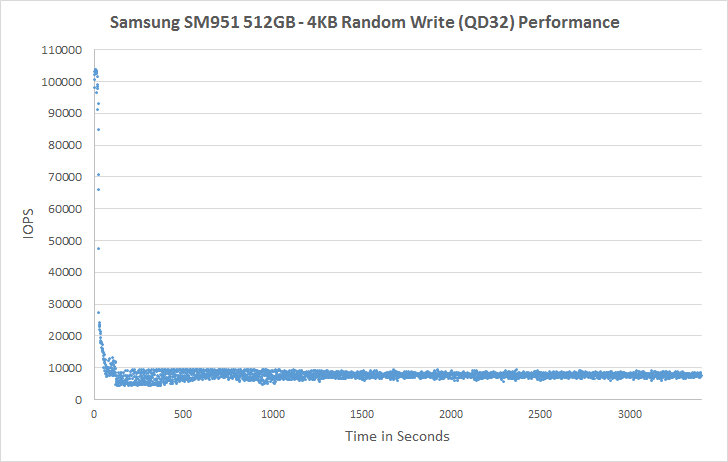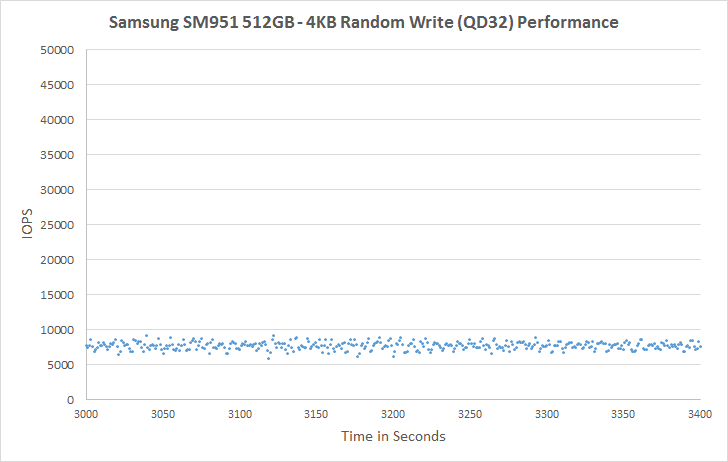Samsung SM951 (512GB) PCIe SSD Review
by Kristian Vättö on February 24, 2015 8:00 AM ESTPerformance Consistency
We've been looking at performance consistency since the Intel SSD DC S3700 review in late 2012 and it has become one of the cornerstones of our SSD reviews. Back in the days many SSD vendors were only focusing on high peak performance, which unfortunately came at the cost of sustained performance. In other words, the drives would push high IOPS in certain synthetic scenarios to provide nice marketing numbers, but as soon as you pushed the drive for more than a few minutes you could easily run into hiccups caused by poor performance consistency.
Once we started exploring IO consistency, nearly all SSD manufacturers made a move to improve consistency and for the 2015 suite, I haven't made any significant changes to the methodology we use to test IO consistency. The biggest change is the move from VDBench to Iometer 1.1.0 as the benchmarking software and I've also extended the test from 2000 seconds to a full hour to ensure that all drives hit steady-state during the test.
For better readability, I now provide bar graphs with the first one being an average IOPS of the last 400 seconds and the second graph displaying the standard deviation during the same period. Average IOPS provides a quick look into overall performance, but it can easily hide bad consistency, so looking at standard deviation is necessary for a complete look into consistency.
I'm still providing the same scatter graphs too, of course. However, I decided to dump the logarithmic graphs and go linear-only since logarithmic graphs aren't as accurate and can be hard to interpret for those who aren't familiar with them. I provide two graphs: one that includes the whole duration of the test and another that focuses on the last 400 seconds of the test to get a better scope into steady-state performance.

In steady-state performance the SM951 provides a substantial ~70% upgrade over the XP941 and brings performance nearly to the same level with the 850 Pro. Given that the 850 Pro uses faster V-NAND, the steady-state performance is a pleasant surprise and shows that the SM951 is more than a marginal bump from the XP941. Obviously, drives with more default over-provisioning (i.e. Extreme Pro and Neutron XT) provide higher steady-state performance, but Samsung is doing very well with the default 7% over-provisioning.

The consistency of the SM951 is also great. The Neutron XT is a living proof of a drive with high average IOPS, but horrible consistency because as we can see in the graph above its standard deviation is up to dozens of times higher compared to the other drives. That's just not acceptable for a modern drive, especially because there are many drives that can consistently provide high IOPS.
 |
|||||||||
| Default | |||||||||
| 25% Over-Provisioning | |||||||||
For a dozen seconds or so, the SM951 is actually able to burst out 100K IOPS, but the performance soon drops to below 10K IOPS and eventually evens out at ~7.5K IOPS. The SM951 is very consistent and doesn't experience any notable IOPS drops, whereas the XP941 regularly drops to a few hundred IOs per second. Increasing the over-provisioning to 25% brings the IOPS to about 35K, which is very decent and again much better than the XP941 that still has odd drops in performance.
 |
|||||||||
| Default | |||||||||
| 25% Over-Provisioning | |||||||||










128 Comments
View All Comments
Railgun - Wednesday, February 25, 2015 - link
Boot times are irrelevant as there, too, there are several variables. BIOS or UEFI? HW involved. Other applications involved. And in the grand scheme of things, it's a one and done thing. If someone is so concerned on booting taking 5 seconds over 30, one can assume they'd leave the thing on. It's an irrelevant metric. Installing an OS again is an irrelevant metric due to the HW involved once again. I've never understood the fascination over boot times.Edgar_in_Indy - Wednesday, February 25, 2015 - link
Boot times and OS installation times (or game installation times, if it makes you feel better) would be interesting because they would be direct reflections of how a drive's theoretical speed is manifest in real world situations.I'm not really sure what your point is, and what you're arguing for. Why would you *not* want a few basic, real world metrics added to the other measurements? *Of course* the test system isn't going to be the same as every user's system. So what? We should still be able to glean some useful information about a drive's relative performance to other drives.
Besides, I have seen some situations where the synthetic tests didn't look great for a particular drive, but in the real world tests it fared much better. This is what led me to choose the Crucial M4 when I was shopping for a 256GB SSD a couple years ago. It wasn't the darling of the synthetic tests, but in the real world scenarios it was right up there with the best of them. It did particularly well in Anand's "Light Workload" test, which seemed much more typical of real-world use than the stress-test type scenarios.
And in regards to the "fascination" with boot times, I think that almost everybody prefers a computer that starts more quickly. I've been around since the DOS days, and that was the last time that I had a computer that booted in seconds, until recently. So having SSD's that can do the same is pretty dang cool to me.
I guess you could also ask a car guy why they have a "fascination" with 0-60 times. I mean, how often will someone really need to get to 60 mph in 5.2 seconds? It's ridiculous to think that somebody would be so worried about 0-60 times, unless they're an Indy Car driver or something.
And besides, there are too many variables (weather, humidity, altitude, tire conditions, driver skill, etc. etc.) to get a definitive 0-60 times, so we may as well junk the whole idea, and just assume that the $60,000 sports car is faster than the $30,000 sports car just because it puts up better numbers on the dyno or has a larger displacement engine.
But I really can't believe I'm having to explain this...
Railgun - Thursday, February 26, 2015 - link
I can't believe you had to explain that as well. You said you want real world tests, which already exist and refer to it during your selection of the M4. How does loading an OS by itself reflect anything? A plain vanilla install is a case that everyone will have only once during the lifecycle of that particular install. You allude to the light workload being more typical, which in itself is more than fine. If you've looked at what's included in the test suites, in particular the destroyer, you'll see that what can be considered normal usage tasks are there.-Download/install games, play games,
-Copy and watch movies,
-Browse the web, manage local email, copy files, encrypt/decrypt files, backup system, download content, virus/malware scan.
How are those not real world tests? They're not synthetic tests. What was your real world scenario that showed the M4 was better than whatever you were comparing it to? Why is that worse, or different than a boot speed test? I too don't hold a lot of value in the synthetic marks. As you mention, it's more for bragging rights than anything else.
I too remember the DOS days. Compared to that, there is no comparison as DOS, compared to Win7 is like comparing a Yugo to a Ferrari. They're both cars and get you from point A to B, but one is so much more than the other. Yes, they're both operating systems, but one has so much more to it and is more complicated than another. DOS 1.0 was about 4000 lines of code. Win7 is around 40 million. What about a nice striped down Linux build? That will load faster. What about Mac OS? Throw in a RAID controller and boot times get tossed out the window.
I don't think anyone has been missing any boot time metrics in the history of testing drives, whether SSD or otherwise. I've not seen one single review anywhere that shows boot times. The ONLY time I've ever seen it was initial comparison between an HDD and SSD. It's a moot point. You know it will be quick. Kristian's point is dead on. We're in the realm of possible milliseconds here. There's no point for the metric.
BTW, I am a car guy, and while 0-60 is all great, I'm more interested in the whole package. Handling, build quality, design, etc. :)
Edgar_in_Indy - Thursday, February 26, 2015 - link
I agree with most everything you said, but I would go back to my original gripe that there was no stopwatch involved. Data rates are great, and let's definitely keep them coming, but I would simply like to see some timed tests too. And even if the timed tests show little or no difference, then that is also a very valuable piece of information.My basic gripe with the article is that it does not clearly answer the question "Should I or shouldn't I?" Sure, some of the graphs are dramatic, but how much will they be manifest in the real world? I think the answer to "Should I buy it?" should be the payoff for reading a big review like this.
And if we can now say that we've reached the point where the real-world difference between SSD's for 99.99% of users is negligible, then I guess it begs the question whether these types of in-depth articles are worth writing, and worth reading, for very much farther into the future.
Kind of like how in-depth sound card reviews have mostly gone away, since we've reached the point where they just work without drawing attention to themselves. Unless you are in the tiny percentile where your occupation relies on having the best soundcard with very specific features, then you don't have to worry about it. Like I said, I came from the DOS days, and for many years soundcards were one of the hottest topics in PC hardware. Now they're pretty much a non-issue.
To draw a non-computer parallel, I'm sure an engineer could also write a 7,000-word review of a particular garbage disposal, going into great detail on every aspect of how the unit is built, but it would be total overkill, because people basically just want to know if it works or not. If SSD's are reaching a level of near-parity, then how many people will want to wade through all the background information in minute detail?
This has been a very informative discussion for me, and in a way it's refreshing to know that I no longer need to sweat about choosing an SSD in the future. That also means that I will be very unlikely to click articles or visit sites that are focused on SSD performance.
Railgun - Thursday, February 26, 2015 - link
I think you and will find, and Kristian, correct me if I'm wrong, that native nvme drives will increase perceived responsiveness as it allows for full on simultaneous read/write IOPS as opposed to unidirectional operations.That should show a nice increase in some scenarios.
Kristian Vättö - Wednesday, February 25, 2015 - link
I find that it's waste of time to run tests that show the obvious, which in this case is that boot and application launch times are the same for all drives. Like I said, it's starting to become common knowledge that for basic workloads there's no difference between SSDs and I've never argued against that.If I did real world testing, I would like to do it right. This means more than timing the boot time and how many tenths of a second it takes to launch a certain app. Frankly that has no value when you consider a power user's workload with dozens of apps already open, of which some might be rather IO intensive (like running a VM).
In such scenarios it can be hard to time the absolute difference because we are talking about stuttering and not seconds long wait times, but it's something that many certainly don't want to experience.
That said, I will probably craft something basic (boot, app and installation times) to show whether PCIe/NVMe has any relevance in basic IO workloads, but it's not something that I'm looking to make a part of our regular test suite since I don't think it gives an accurate picture of actual real world performance under multitasking workloads.
Edgar_in_Indy - Wednesday, February 25, 2015 - link
So would you say we're reaching the point where having the "fastest" SSD is really mostly about bragging rights?If that's the case, then it seems like the two most important specifications of an SSD would be size and price (much like it is for platter HDD's now). It would certainly make shopping for an SSD much simpler, if relative speed is no longer a meaningful factor.
Kristian Vättö - Wednesday, February 25, 2015 - link
Yes, and I don't think I've been trying shovel the high-end SSDs down people's throat.I think the SSD market mainly consists of two segments now, which are the mainstream and enthusiast/professional segments. For the mainstream segment, any modern SSD is good enough, which is why $/GB has been the dominating factor when I recommend drives for that market (and that's why the MX100 has been my recommendation for quite some time now if you've seen our "Best SSDs" articles).
The high-end sector is different in the sense that the users tend to want the best performance they can get. In some cases it's just for the bragging rights, but there are also workloads where SSD performance really matters (multiple VMs, photo/video/audio editing, etc). Some of our tests are more geared towards these users and I think we've been pretty clear about that, but as you said the Light workload test does a good job of illustrating average consumer usage and frankly the difference between drives in that test is rather small.
My goal has never been to push people to buy "faster" drives than they need and if some of my writings have come across as that then please, give me some examples and I'll try to learn from those.
Edgar_in_Indy - Wednesday, February 25, 2015 - link
No, I'm not trying to say that you've been pushing people to faster or more expensive SSD's. And even if you were, I probably wouldn't know, since I don't read all the SSD articles on here and follow all the developments. I mostly just jump in every year or two when I'm shopping for upgrades, and I try to play catch-up at that point in order to make sure I'm spending my money as wisely as possible.So for someone like me, who doesn't follow this stuff religiously, it's good to know I don't need to worry about missing out on big speed gains by not getting the hottest SSD of the moment next time I want to upgrade.
That being said, I'm still a little bit of a performance enthusiast, so I can't help but be curious when something like this comes along and shows the potential for big improvements over previous designs. That's why I was a little disappointed to not find much in the way of real-world results.
Anyway, it's obvious you put a lot of time and effort into this review, and the some of the performance results really were dramatic, so this is some good work.
Redstorm - Tuesday, February 24, 2015 - link
Why when updating the storage bench system did you pick a motherboard without a m.2 x 4 PCIe 3.0 slot. The Asus Z97 Delux is only providing 2 x pcie 2.0 lanes to the onboard M.2 slot. seams a bit short sited with the impending avalanche of x4 PCIe 3.0 SSD controllers coming out. Your new bench system is obsolete before it began. Using PCIe adapters is old school..